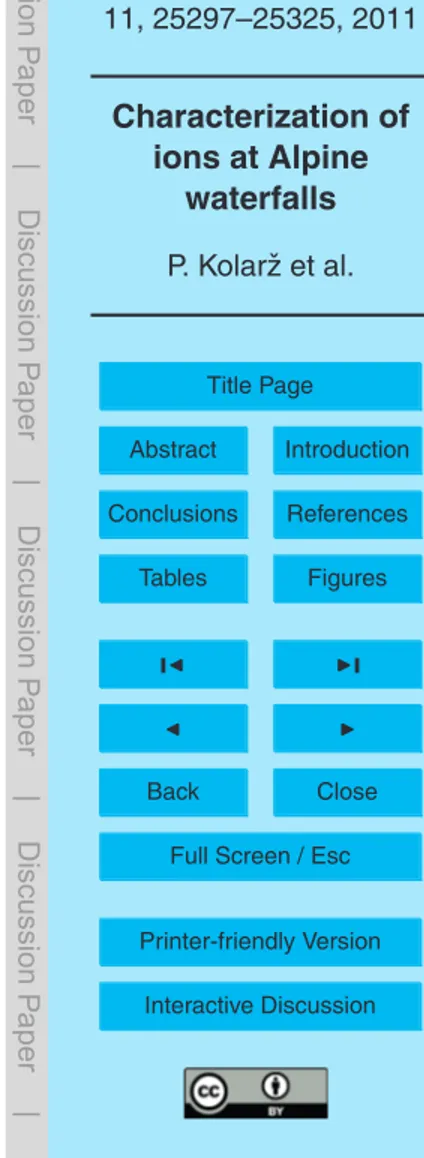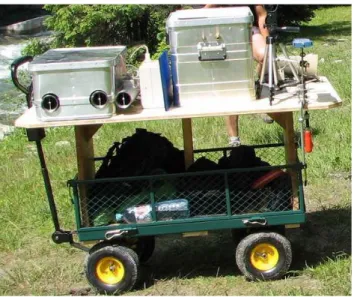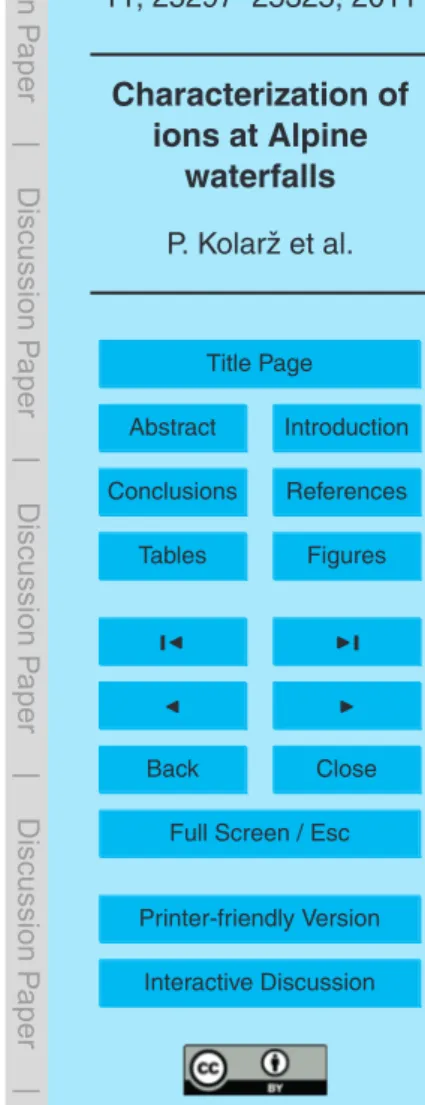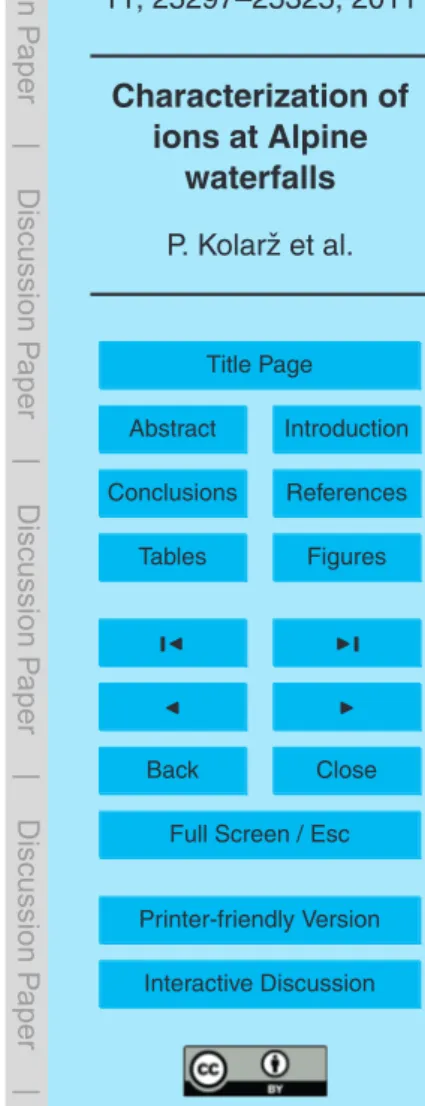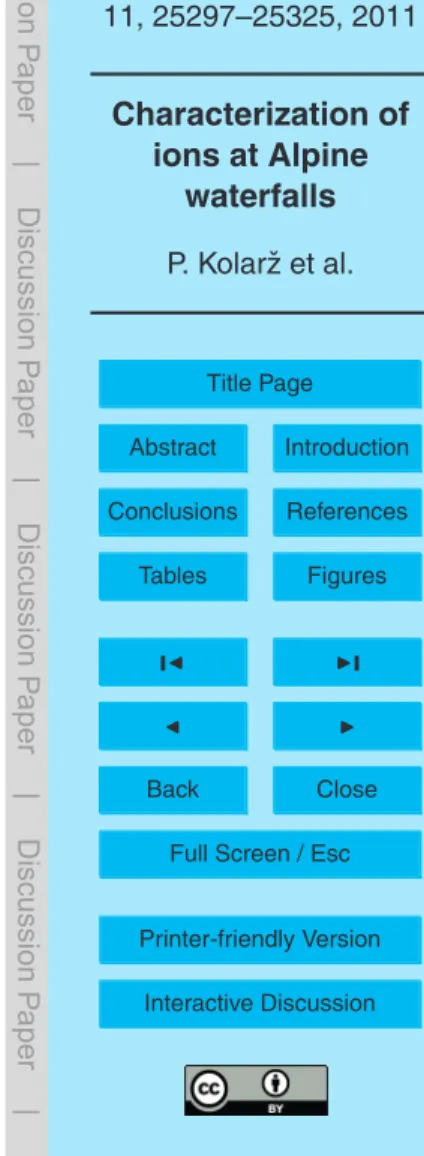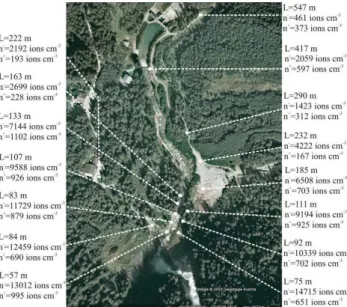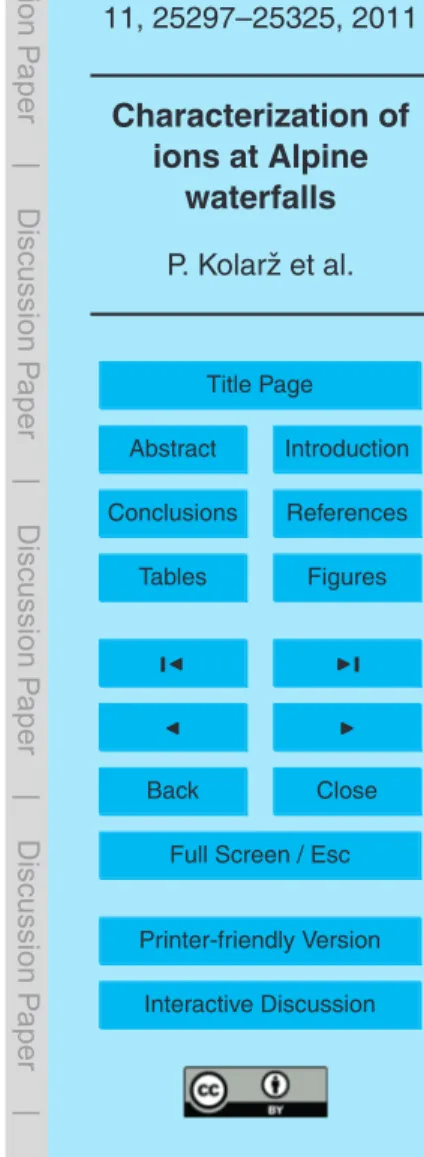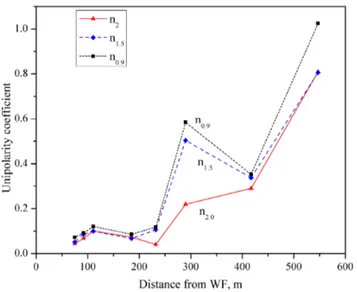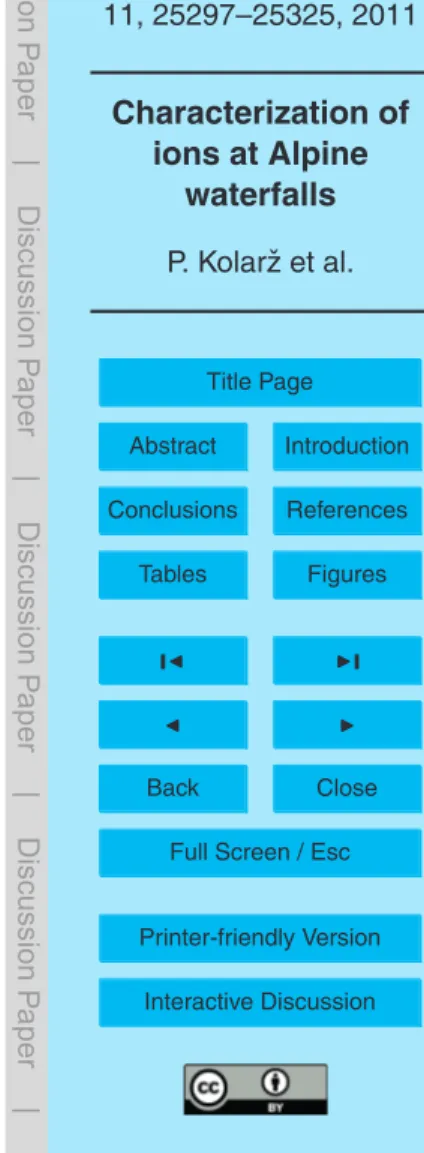ACPD
11, 25297–25325, 2011Characterization of ions at Alpine
waterfalls
P. Kolarˇz et al.
Title Page
Abstract Introduction
Conclusions References
Tables Figures
◭ ◮
◭ ◮
Back Close
Full Screen / Esc
Printer-friendly Version Interactive Discussion
Discussion
P
a
per
|
Dis
cussion
P
a
per
|
Discussion
P
a
per
|
Discussio
n
P
a
per
Atmos. Chem. Phys. Discuss., 11, 25297–25325, 2011 www.atmos-chem-phys-discuss.net/11/25297/2011/ doi:10.5194/acpd-11-25297-2011
© Author(s) 2011. CC Attribution 3.0 License.
Atmospheric Chemistry and Physics Discussions
This discussion paper is/has been under review for the journal Atmospheric Chemistry and Physics (ACP). Please refer to the corresponding final paper in ACP if available.
Characterization of ions at Alpine
waterfalls
P. Kolarˇz1,*, M. Gaisberger2.*, P. Madl3, W. Hofmann3, M. Ritter2, and A. Hartl2
1
Institute of Physics, University of Belgrade, Pregrevica 118, 11080 Belgrade, Serbia
2
Paracelsus Medical University, Institute for Physiology and Pathophysiology, Strubergasse 21, 5020 Salzburg, Austria
3
University of Salzburg, Department of Materials Research and Physics, Division of Physics and Biophysics, Hellbrunner Str. 34, 5020 Salzburg, Austria
*
These authors contributed equally to this work.
Received: 16 June 2011 – Accepted: 4 September 2011 – Published: 9 September 2011
Correspondence to: P. Kolarˇz (kolarz@ipb.ac.rs)
ACPD
11, 25297–25325, 2011Characterization of ions at Alpine
waterfalls
P. Kolarˇz et al.
Title Page
Abstract Introduction
Conclusions References
Tables Figures
◭ ◮
◭ ◮
Back Close
Full Screen / Esc
Printer-friendly Version Interactive Discussion
Discussion
P
a
per
|
Dis
cussion
P
a
per
|
Discussion
P
a
per
|
Discussio
n
P
a
per
|
Abstract
During a three-year field campaign of measuring waterfall generated ions, we moni-tored five different waterfalls in the Austrian Alps. Most measurements were performed at the Krimml waterfall (Salzburg), which is the biggest and most visited one in Europe and the Gartl waterfall (M ¨olltal, Carinthia). Smallest ion sizes (0.9–2 nm) were mea-5
sured with a cylindrical air ion detector (CDI-06) while ion sizes from 5.5 to 350 nm were measured using a modified Grimm SMPS aerosol spectrometer. Measurements showed high negative ion gradients nearby waterfalls whereas positive ions showed only a moderate increase. The most abundant sizes of nano-sized and sub-micrometer ions measured were at 2 nm and of the larger and heavier ones at 120 nm.
10
1 Introduction
1.1 Air ions in the environment
The term “air ions” refers to all charged airborne particles that have electrical mobil-ity. In general, they are continually created by natural sources such as cosmic rays, radioactive decay of noble gases (such as radon) in the air and radioactive minerals 15
from the ground. After the ionization process and in a very short time (typically mi-croseconds) primary ions evolve via a process of hydration and ion cluster formation into complexes known as small air ions (charged nano-aerosols) with a lifetime of up to 100 s. The central ion of a cluster could contain one inorganic molecule and be sur-rounded by one layer of water molecules. However, due to the purity of the water, such 20
ACPD
11, 25297–25325, 2011Characterization of ions at Alpine
waterfalls
P. Kolarˇz et al.
Title Page
Abstract Introduction
Conclusions References
Tables Figures
◭ ◮
◭ ◮
Back Close
Full Screen / Esc
Printer-friendly Version Interactive Discussion
Discussion
P
a
per
|
Dis
cussion
P
a
per
|
Discussion
P
a
per
|
Discussio
n
P
a
per
The ion concentration (n±) itself is determined by the following balance equation: d n±
d t =q−αn
±
n∓
−n±
βZ (1)
whereq is the volumetric production rate,Z is the aerosol number concentration and α, β account for the losses of ion to ion recombination and ion-aerosol attachment. Mobility of the positive air ions is lower (as the diameter is larger) resulting in a higher 5
neutralization coefficientβ of negative ions and consequently yields lower concentra-tions in the natural surroundings (Eq. 1). The average ratio of positive and negative ion concentrations, i.e. the unipolarity coefficient, in natural surroundings isn+/n−=1.12 (H ˜orrak, 2001).
According to the size categorization provided by H ˜orrak (2001), air ions are clas-10
sified in small (sub-nano-sized 0.42–0.85 nm), big clusters (nano-sized 0.85–1.6 nm), intermediate (1.6–7.5 nm), light large (7.5–22 nm) and heavy large (sub-micrometer 22–79 nm) clusters. Intermediate and large ions are also called aerosol ions (H ˜orrak et al., 1994). Air ions are supposed to carry only a single elementary charge that relates mobility with mass if the carrier gas is known (Aplin, 2008). The relationship between 15
ion radius and mobility was calculated using the algorithm given by Tammet (1995). There are many natural and artificial mechanisms of air ion generation in the envi-ronment. In this study, we investigated the “waterfall effect”, which creates mostly neg-ative ions, also known as Lenard‘s ions (Lenard, 1892). Upon creation, WF droplets undergo charge redistribution forming dipoles with negatively charged surfaces. The 20
phenomenon of charge separation occurs as a consequence of disruption of the water surface by splashing and bubbling when moving liquid is aerosolized at an obstacle or by aerodynamic up of water droplets during free fall (see Fig. 1). After break-up by whatever mechanism, smaller fragments (or clusters) are carrying negatively charged OH− ions, while the remaining bigger fragments are positive where large pro-25
ton clusters are known as H3O+(H2O)20 (Parts et al., 2007; Luts et al., 2009; Hulthe et
ACPD
11, 25297–25325, 2011Characterization of ions at Alpine
waterfalls
P. Kolarˇz et al.
Title Page
Abstract Introduction
Conclusions References
Tables Figures
◭ ◮
◭ ◮
Back Close
Full Screen / Esc
Printer-friendly Version Interactive Discussion
Discussion
P
a
per
|
Dis
cussion
P
a
per
|
Discussion
P
a
per
|
Discussio
n
P
a
per
|
the gas phase while the positive pole is oriented towards the liquid phase (Parfenyuk, 2002).
(H2O)n→(H3O+)(H2O)n−m +OH
−
(H2O)m−2wherem≫n.
Botti et al. (2004) suggested that OH− ions are hydrated with 4 H2O molecules with
a presence of a weakly bound fifth water molecule close to the hydrogen atoms. Neg-5
atively charged particles remain in the air and become thermophoretically dispersed due to the cold air stream caused by the temperature difference of the water and the surrounding air. The larger positively charged droplets precipitate to the ground, i.e. in the pond. As a result, negative air ion concentrations near WFs easily reach several tens of thousands per cubic centimetre.
10
Laakso et al. (2007) found that the diameter of WF-related negative air ions range between 1.5–10 nm, whereby 2 nm sized negative ions were most abundant.
Physiological and medical effects of ions and waterfalls has been described (Iwama, 2004; Yamada et al., 2005; Takahashi et al., 2008), but interpretation of specific health related effects still require a thorough physical characterization, especially when related 15
to waterfalls.
2 Methods
2.1 Instrumentation and measurements
Ion concentrations of 0.9, 1.5, 2 nm diameter were measured using 3 identical air ion detectors (CDI-06) based on the aspirated Gerdien condenser principle (Gerdien, 20
1905), made in the Institute of Physics, Belgrade. All detectors have their own power supply, temperature, pressure and relative humidity sensors, and also features such as dynamic zeroing, live data acquisition, with programmable data averaging, sam-pling and polarity change (Kolarˇz et al., 2005, 2009). The critical mobility (µc), i.e. the
ACPD
11, 25297–25325, 2011Characterization of ions at Alpine
waterfalls
P. Kolarˇz et al.
Title Page
Abstract Introduction
Conclusions References
Tables Figures
◭ ◮
◭ ◮
Back Close
Full Screen / Esc
Printer-friendly Version Interactive Discussion
Discussion
P
a
per
|
Dis
cussion
P
a
per
|
Discussion
P
a
per
|
Discussio
n
P
a
per
polarizing voltage (U) and air flow:
µc=
VSR22−R12
lnR2R 1
2LU (2)
whereR2 and R1 are the radii of the polarizing and collecting electrode;L is the col-lecting electrode length andVS is the air velocity through the electrodes. Air-flow and polarizing voltage on 3 detectors were set to measure air ions in size ranges≤0.9, 1.5 5
and 2 nm (Eq. 2). These three values are depicted due to characteristic sizes of ions created by WF, which is around 2 nm (Laakso et al., 2007) and by nuclear decay as well as cosmic rays – with the latter up to 0.9 nm. It is expected that simultaneous measure-ments of all three instrumeasure-ments on places where no WF-related ions are present should show approximate air ion concentrations. The instrumental uncertainties under regular 10
conditions are about 5 % (Kolarˇz et al., 2009). Taking into account the extreme and difficult conditions during the field campaign and particularly near the WFs, an addi-tional uncertainty should be added. Yet, efforts, such as maintaining constant RPM of the fans, thermostated electronics and electrodes, use of additional protective case and manual zeroing procedure have been employed to limit uncertainties to additional 15
10 %. Altogether, by using the “root-sum-of-squares” method the overall uncertainty amounts to 11 %.
Air ion particles in the size range from 5.5 to 358 nm were measured with the Grimm SMPS (Scanning Mobility Particle Sizer) using an M-DMA (Medium-Differential Mobility Analyzer) for size class differentiation and an attached CPC (Condensation 20
Particle Counter) to quantify the particle concentration. Within the DMA, the parti-cles are selected according to their electrical mobility, which is accomplished using a241Am radioactive source mounted on the DMA air inlet. To avoid neutralization of the aerosolised ions, this so-called “neutralizer” was detached from the M-DMA. Doing so one obtains an SMPS detector that is able to count negatively charged particles. 25
ACPD
11, 25297–25325, 2011Characterization of ions at Alpine
waterfalls
P. Kolarˇz et al.
Title Page
Abstract Introduction
Conclusions References
Tables Figures
◭ ◮
◭ ◮
Back Close
Full Screen / Esc
Printer-friendly Version Interactive Discussion
Discussion
P
a
per
|
Dis
cussion
P
a
per
|
Discussion
P
a
per
|
Discussio
n
P
a
per
|
Atmospheric data like temperature and wind speed were measured by a PCE-007 anemometer attached to a data logger.
Measurement of ion concentrations in the vicinity of the WF is difficult and restricted due to the existence of dispersed drops in the air (water aerosols). These droplets are not only contributing to the increase in relative humidity but also in wetting the 5
instruments, soaking the electrodes of the CDI, thereby causing current leakages in the electrode system and amplifying electronics.
In addition, the temperature gradient at the falls results in a heavy surge, which is directed away from the WF downstream in periodical gusts – especially at the Krimml WF. These gusts are carrying water aerosols, and are usually, but not always, higher 10
loaded with air ions. Periods of intense gusts are followed by modest ones and typically last for a few tens of seconds.
These conditions limit the duration of the measurements and act as a delimiting fac-tor when attempting to obtain a comprehensive outline of the invenfac-tory at the falls. All these difficulties were partially avoided by encasing the CDI instruments in aluminium 15
boxes with inlets for the probes and outlet for exhaust and excess heat. These cases also contributed to the protection of control- and supply units. The SMPS was also operated in a sealed housing, thus only the inlet was subject to excessive humidity. All instruments were mounted onto a 4-wheel trolley fitted with a tow rail (Fig. 2). It is small enough to be loaded onto a pick-up truck in order to approach different falls at different 20
off-road locations.
3 Measurements and discussion
3.1 Study of 5 different WFs
During the summer of 2008, five WFs in Austria were studied and compared with con-trol sites where WF-related ions were not present. Table 1 shows average and maximal 25
ACPD
11, 25297–25325, 2011Characterization of ions at Alpine
waterfalls
P. Kolarˇz et al.
Title Page
Abstract Introduction
Conclusions References
Tables Figures
◭ ◮
◭ ◮
Back Close
Full Screen / Esc
Printer-friendly Version Interactive Discussion
Discussion
P
a
per
|
Dis
cussion
P
a
per
|
Discussion
P
a
per
|
Discussio
n
P
a
per
WF. All WF ion concentrations were measured at places of maximal ionization and moderate wetting of the instruments. The highest average concentration increase of 2 nm-sized negative ions – in comparison to control point’s concentration – was found to be 80-fold.
WF ion concentrations fluctuate depending on measuring sites, but their averages 5
at the examined sites typically depend on the quantity of water flow, which varies sea-sonally. In contrast, the origin and structure of the ions generated at reference sites arise mostly from natural radioactivity, which is subject to diurnal changes (Kolarˇz et al., 2009; Chandrashekara, et al., 2006). Accordingly, the presented relations between WF and background ions vary diurnally and seasonally.
10
The data in Table 1 lead to the conclusion that the production of WF ions not only depends on the height of the WF and its quantity of water flowing per unit of time, but also on the location of the WF, the surrounding topography, and of course, the location of the measuring points.
Larger WFs create periodical gusts, which are usually carrying a lot of water droplets 15
that can be seen with the naked eye and likewise felt on the skin. These gusts do not necessarily carry small water droplets but when they do, the resulting increase in concentration of WF-generated ions are immediately detected by the instruments. This is especially significant at the Krimml WF where three falling cascades generate very complex air-flow patterns.
20
Figure 3 shows the artificial WF with a cascade that is 5 m high on the river M ¨oll. Although ion concentrations are 11-fold higher than background measurements, they are much lower than any of the higher WFs (Table 1). This supports the assumption that one of the processes that contribute to WF ion generation is charge separation via aerodynamic break-up of micrometer-sized water droplets into nano-sized aerosols 25
ACPD
11, 25297–25325, 2011Characterization of ions at Alpine
waterfalls
P. Kolarˇz et al.
Title Page
Abstract Introduction
Conclusions References
Tables Figures
◭ ◮
◭ ◮
Back Close
Full Screen / Esc
Printer-friendly Version Interactive Discussion
Discussion
P
a
per
|
Dis
cussion
P
a
per
|
Discussion
P
a
per
|
Discussio
n
P
a
per
|
Hence, as one moves away from the waterfall and due to the change in super-saturated conditions, the corresponding Kelvin droplet diameter becomes larger as under-saturated conditions are reached (decrease in relative humidity and increase in temperature), which causes the aerosols to shrink in size, further accounting to a smaller particle sized diameter. However, the most prominent mechanism of formation 5
is encountered when the water droplets hit a surface (water, or rock), thereby fragment and in combination with the above (bubble bursting effect, as shown in Fig. 1) yield nano-sized aerosols.
3.2 Ion inventory at the Krimml WF
The Krimml WF is located in the northern region of the “Hohe Tauern” – a part 10
of the eastern alpine region. It belongs to a glacial creek named “Krimmler Ache” whose water flows according to the season. In July the average throughput is about 20 000 m3h−1, whereas it is only 500 m3h−1in February. The WF itself consists of three consecutive cascades, with a height of 140 m, 100 m and 140 m high (Fig. 4). The base of the WF is at an altitude of around 1100 m above sea level. The height of the last 15
WF cascade provides maximal velocity to water droplets as the flow reaches 53 m s−1. The chemical composition of the water reveals an almost neutral pH (7.36) with very low concentrations of Ca2+ (3.45 mg L−1), Mg2+ (1.22 mg L−1) and Cl− (0.26 mg L−1). The conductivity was 30 µS cm−1.
From a microbiological point of view, the water quality showed a moderate enraged 20
count of colony forming units (100 CFU ml−1). Simultaneous measurements of small clusters, intermediate and large ions created by the WF and natural ionizing radiation were performed – shown in Fig. 4 – over a two-week period in July 2010 on both sides of the bottom cascade at the Krimml WF.
To test the performance of the instrumentation, an inter-comparison between the 25
ACPD
11, 25297–25325, 2011Characterization of ions at Alpine
waterfalls
P. Kolarˇz et al.
Title Page
Abstract Introduction
Conclusions References
Tables Figures
◭ ◮
◭ ◮
Back Close
Full Screen / Esc
Printer-friendly Version Interactive Discussion
Discussion
P
a
per
|
Dis
cussion
P
a
per
|
Discussion
P
a
per
|
Discussio
n
P
a
per
for translocation among the various sampling sites and for the slow approach to the nearest point of the orographic right side at the falls. The Figure reveals the Pearson correlation factor ofr=0.97, which is more than satisfactory considering the measur-ing conditions encountered durmeasur-ing the campaign (Fig. 5). Testmeasur-ing was conducted also at different sites and locations.
5
Gradients of≤2 nm size positive and negative air ion concentrations measured dur-ing the three-week field campaign at the Krimml WFs in July 2010 are shown in Fig. 6. Distances were measured from the base of the lowest cascade (using Google earth coordinates: 47.208283 N/12.170859 E). On the orographic right side, with the last measuring points being the reference site some 547 m away from the falls, assuming 10
that no WF-related ions are present there. The reason for the relatively short gradient distance on the orographic left side is due to the dense forest cover that dominates the farther site some 228 m from the WF. The differences between the maximal values on the left and the right side of the WF, i.e. the creek, arise from the topographic configu-ration, the time variations when measurements were performed, turbulent air flows and 15
varied solar flux within the upper Krimml valley.
All ion measurements were carried out at points that ensure that the instruments were not subject to instant flooding. Accordingly, the nearest measuring points were 57 m and 75 m on the orographic left and right side of the Krimml WF, respectively. Both measuring points are slightly shifted out of the main axis, which is directed sharply to 20
the left orographic uphill side (Fig. 4 and aerial view of Fig. 6). The lower concentration on the left side is the result of complex turbulent air-flow generated by the huge amount of water pouring into the pond.
In comparison with the other WFs that we measured (Table 1), the maximal ion concentrations generated near the Krimml WF were apparently low, i.e. only about 20 25
ACPD
11, 25297–25325, 2011Characterization of ions at Alpine
waterfalls
P. Kolarˇz et al.
Title Page
Abstract Introduction
Conclusions References
Tables Figures
◭ ◮
◭ ◮
Back Close
Full Screen / Esc
Printer-friendly Version Interactive Discussion
Discussion
P
a
per
|
Dis
cussion
P
a
per
|
Discussion
P
a
per
|
Discussio
n
P
a
per
|
the instrumentation is much more prevalent than at the other WFs. Due to the dynam-ics of waterfall generated aerosols, monitoring the inventory with a SMPS is not the first choice, as it requires a 120 s interval for the completion of a full scan. The ideal detector should at least measure in seconds intervals, like the ELPI. However this in-strument – due to its weight and power requirements – makes field measurements a 5
real challenge. In order to overcome this shortage, at least 3 full SMPS scans were made at every point, each divided into 44 size channels and each channel computed as an average of 9 individual recordings (out of which the 1st and the 9th are omitted as the system dynamically changes the voltage when switching from one size bin to the next). Using the SMPS and due to the nature of its detection principle it measures only 10
negatively charged particles. Consequently, it deprived us from the ability to monitor the increase of positively charged aerosols in the 200 nm size range and beyond, as reported by Reiter (1994).
3.3 Ion measurements at the Krimml WF
Gradients of 0.9, 1.5 and 2 nm size positive and negative integral ion concentrations 15
are shown in Fig. 7. As mentioned before, the non-linear decay function of the negative ion concentration is caused by the local topography and wind patterns. Positive ions did not reveal significant increases in concentrations and only 2 nm sized ions showed a nice correlation (r=0.6) between positive and negative ions gradients. Interestingly enough, all three dimensions of positive ions were rising with distance within the first 20
hundred meters from the waterfall only to decrease further afield. This is probably due to very high concentrations of negative ions as well as aerosols in the vicinity of the waterfall. This implies that higher coefficients ofαandβ(see Eq. 1) amplified by strong turbulent air flow patterns must be taken into consideration.
Equalization of the smallest positive and negative air ion concentrations is a signal 25
ACPD
11, 25297–25325, 2011Characterization of ions at Alpine
waterfalls
P. Kolarˇz et al.
Title Page
Abstract Introduction
Conclusions References
Tables Figures
◭ ◮
◭ ◮
Back Close
Full Screen / Esc
Printer-friendly Version Interactive Discussion
Discussion
P
a
per
|
Dis
cussion
P
a
per
|
Discussion
P
a
per
|
Discussio
n
P
a
per
visible in Figs. 7, 8, 9. The average wind speed from the first to the last point measured was 4.6 m s−1. Approximate calculations showed that under these circumstances, WF-related ions could persist up to 120 s.
Supplementary measurements done at various locations showed radon concentra-tions in the water above and below the Krimml WF to be 141 and 148 Bq m−3, re-5
spectively (measured with a RAD-7 instrument, Durridge Co, USA), hence they re-main neglected for the overall ion production rate. Also, natural radioactivity in the air was measured with a Gamma Scout counter showing typical background values of
∼0.15 mSv h−1. As outlined in the “Methods”, the particle diameter range from 0.9 to 350.4 nm was measured using CDI-06 and modified SMPS with M-DMA at 5 measur-10
ing points (Fig. 9).
The air ion concentration peak at the reference point (547 m) is slightly shifted to smaller ion sizes and as outlined above, as a result of different source and formation mechanisms. Air ions created by ionizing radiation are smaller than WF-related ions. Their size range is shown by the reference point data series (547 m) where 0.9 nm ions 15
were the most abundant.
According to Laakso et al. (2007), the ion-effect of the WF is visible only in ions smaller than approximately 30 nm with a maximal rise of negative ions concentration near the WF in the size range of 1.5 to 10 nm. Our measurements showed that WF-generated ions up to 25 nm with a corresponding maximal concentration increase mea-20
sured at 2 nm – which assorts well with Laakso et al. (2007) – in particular when keep-ing in mind the differences arising from measuring conditions, temperature and size of the WF.
In the size range between 25 and 40 nm there is no increase in observable WF-generated ions, whereas larger ions are present from 40 to above 350 nm, whereby 25
ACPD
11, 25297–25325, 2011Characterization of ions at Alpine
waterfalls
P. Kolarˇz et al.
Title Page
Abstract Introduction
Conclusions References
Tables Figures
◭ ◮
◭ ◮
Back Close
Full Screen / Esc
Printer-friendly Version Interactive Discussion
Discussion
P
a
per
|
Dis
cussion
P
a
per
|
Discussion
P
a
per
|
Discussio
n
P
a
per
|
size range along with its mobility.
3.4 Ion measurements at the Gartl WF
The Gartl WF – as shown in Fig. 10 – is located in the southern sector of the “Hohe Tauern” region and is also part of the central eastern inner alpine region. It is composed of 2 cascades that together are about 50 m high and steeply precipitating to the pond 5
at the base of the falls. This WF is tightly embedded into a narrow topographic setting, encompassing a small valley opening and thereby closely surrounded with high cliffs, which are directing the air stream downhill.
The generated ion gradients at Gartl WF show similar trends as observed at Krimml WF. However with significantly higher ion concentrations than at Krimml WF, despite 10
the moderate wind that was prevailing in the direction out of the narrow valley, which reduces the concentration of WF generated ions.
Unlike Krimml WF, the positive ion concentrations at Gartl WF revealed a similar trend as for documented negative ions, but still with an 18 fold lower concentration in the vicinity of the fall itself. As a result, strong correlation factors between same-sized 15
positive and negative ions (r∼0.8) were obtained (Fig. 11) but with huge deviations in overall concentration. The ratio between negative and positive gradients of ions is shown in Fig. 12, where slightly increased background concentrations of both air ion polarities could be observed (point at 120 m).
Figure 13 depicts the negative ion concentrations vs. aerosol size measured at Gartl 20
WF. It likewise reveals a similar size distribution as observed at Krimml WF (compare with Fig. 9). This very satisfying observation is striking as there is a significant diff er-ence in both the topography and the height of the falls. The referer-ence site was located near the D ¨ollach village (Carinthia), a few kilometres aside the falls on the opposite side of the valley.
ACPD
11, 25297–25325, 2011Characterization of ions at Alpine
waterfalls
P. Kolarˇz et al.
Title Page
Abstract Introduction
Conclusions References
Tables Figures
◭ ◮
◭ ◮
Back Close
Full Screen / Esc
Printer-friendly Version Interactive Discussion
Discussion
P
a
per
|
Dis
cussion
P
a
per
|
Discussion
P
a
per
|
Discussio
n
P
a
per
4 Conclusion
Concentrations and size distributions of WF-generated ions in the size range from 0.9 to 350 nm were measured at 2 WFs in the Austrian Alps using a Gerdian-type ion counter and a Scanning Mobility Particle Sizer adapted for ion counting purposes. The WFs herein studied reveal totally different topographical settings, yet their ion size dis-5
tribution was found to be almost identical and in very good agreement with Laakso et al. (2007). The abundance of negative nano-sized and intermediate ions generated by these WFs was found to be in the size range of 0.2–25 nm with a maximal concentra-tion peak measured at 2 nm. On the other hand, heavier sub-micrometer ions in the range of 40 to 350 nm peaked in a size window at around 120 nm. The generation of 10
1.5 nm ions was less dominant than those at 0.9 and 2.0 nm.
Positive ions are also generated by these WFs, and their concentrations also differ at each WF; a fact that can most likely be ascribed to the increase of the recombination coefficientα(refer to Eq.1). Measurements at these various WFs show that the number of generated ions depends on numerous parameters such as topographic configuration 15
(surrounding cliffs), quantity of water, altitude, weather and prevailing humidity levels. These parameters determine the quantity of aerosolised water in the form of the ion neutralization coefficient. Compared with the measurements from the artificial WF, we can conclude that bubble break-up on solid surfaces along with splashing of water on aqueous surfaces is a major ionizing source and exceeds the aero dynamic break-up 20
of larger water droplets by far.
ACPD
11, 25297–25325, 2011Characterization of ions at Alpine
waterfalls
P. Kolarˇz et al.
Title Page
Abstract Introduction
Conclusions References
Tables Figures
◭ ◮
◭ ◮
Back Close
Full Screen / Esc
Printer-friendly Version Interactive Discussion
Discussion
P
a
per
|
Dis
cussion
P
a
per
|
Discussion
P
a
per
|
Discussio
n
P
a
per
|
References
Aplin, K. L.: Composition and measurement of charged atmospheric clusters, Space Sci. Rev., 137, 213–224, 2008.
Botti, A., Bruni, F., Imberti, S., Ricci, M. A., and Soper, A. K.: Solvation shell of OH−
ions in water, J. Mol. Liq., 117, 81–84, 2004.
5
Chandrashekara, M. S., Sannapp, J., and Paramesh, L.: Studies on atmospheric electrical con-ductivity related to222Rn and its progeny concentrations in the lower atmosphere at Mysore, Atmos. Environ., 40, 87–89, 2006.
Gerdien, H.: Demonstration eines Apparates zur absoluten Messung der elektrischen Leit-fahigheit der Luft, Phys. Zeitung, 6, 800–801, 1905.
10
H ˜orrak, U.: Air ion mobility spectrum at a rural area. Dissertationes Geophysicales Universitat Tartuensis, Tartu, Estonia, 2001.
H ˜orrak, U., Iher, H., Luts, A., Salm, J., and Tammet, H.: Mobility spectrum of air ions at Tahkuse Observatory, J. Geophys. Res., 99, 10697–10700, 1994.
Hulthe, G., Stenhagen, G., Wennerstr ¨om, O., Ottosson, CH.: Water clusters studied by elec-15
trospray mass spectrometry, J. Chromatogr. A., 777, 155–165, 1997.
Iwama, H.: Negative air ions created by water shearing improve erythrocyte deformity and aerobic metabolism, Indoor Air, 14, 293–297, 2004.
Laakso, L., Hirsikko, A., Gronholm, T., Kulmala, M., Luts, A., and Parts, T.-E.: WFs as sources of small charged aerosol particles, Atmos. Chem. Phys., 7, 2271–2275, doi:10.5194/acp-7-20
2271-2007, 2007.
Lenard, P.: ¨Uber die Elektrizit ¨at der Wasserf ¨alle, Ann Phys (Leipz), 46,584-636, 1892.
Luts, A., Parts, T., Laakso, L., Hirsikko, A., Gr ¨onholm, T., and Kulmala, M.: Some air electricity phenomena caused by WFs, Correlative study of the spectra, Atmos. Res., 91, 229–237, 2009.
25
Kolarˇz, P., Filipovi, D., and Marinkovi, B.: Daily variations of indoor air-ion and radon concen-trations, Appl. Radiat. Isotopes, 67, 2062–2067, 2009.
Kolarˇz, P., Filipovi, D., Marinkovi, B.: Zeroing and testing units developed for Gerdien atmo-spheric ion detectors, Rev. Sci. Instrum., 76, 046107, 2005.
Parfenyuk, V. I.: Surface potential at the gas-aqueous solution interface, Colloid J., 64, 588– 30
595, 2002.
compo-ACPD
11, 25297–25325, 2011Characterization of ions at Alpine
waterfalls
P. Kolarˇz et al.
Title Page
Abstract Introduction
Conclusions References
Tables Figures
◭ ◮
◭ ◮
Back Close
Full Screen / Esc
Printer-friendly Version Interactive Discussion
Discussion
P
a
per
|
Dis
cussion
P
a
per
|
Discussion
P
a
per
|
Discussio
n
P
a
per
sition of waterfall-induced air ions, spectrometry vs. simulations, Boreal. Environ. Res., 12, 409–420, 2007.
Reiter, R.: Charges on particles of different size from bubbles of Mediterranean Sea surf and from waterfalls, J. Geophys. Res., 99(D5), 10807–10812, 1994.
Takahashi, K., Otsuki, T., Mase, A., Kawado, T., Kotani, M., Ami, K., Matsushima, H., Nishimura, 5
Y., Miura, Y., Murakami, S., Maeda, M., Hayashi, H., Kumagai, N., Shirahama, T., Yoshi-matsu, M., and Morimoto, K.: Negatively-charged air conditions and responses of the human psycho-neuro-endocrino-immune network, Environ. Int., 34(6), 765–772, 2008.
Tammet, H.: Size and mobility of atmospheric particles, clusters and ions, J. Aerosol. Sci., 26, 459–475, 1995.
10
Yamada, R., Yanoma, S., Akaike, M., Tsuburaya, A., Sugimasa, Y., Takemiya, S., Motohashi, H., Rino, Y., Takanashi, Y., and Imada, T.: Water-generated negative air ions activate NK cell and inhibit carcinogenesis in mice, Cancer Lett., 239, 190–197, 2005.
Vostrikov, A. A., Drozdov, S. V., Rudnev, V. S., and Kurkina, L. I.: Molecular dynamics study of neutral and charged water clusters, Comput. Mater. Sci., 35, 254–260, 2006.
15
ACPD
11, 25297–25325, 2011Characterization of ions at Alpine
waterfalls
P. Kolarˇz et al.
Title Page
Abstract Introduction
Conclusions References
Tables Figures
◭ ◮
◭ ◮
Back Close
Full Screen / Esc
Printer-friendly Version Interactive Discussion
Discussion
P
a
per
|
Dis
cussion
P
a
per
|
Discussion
P
a
per
|
Discussio
n
P
a
per
|
Table 1. Overview of the ion (≤2 nm) concentrations measured at closest range of the WFs and at control places (CP).
WF name Average WF ion conc. Max. WF ion conc. Average ion conc. at ref. site Conc. increase Conc. increase [ions m−3
] [ions m−3
] [ions m−3
] n−
WF/n −
CP n + WF/n+CP
negative positive negative positive negative positive
Krimml 16581 1040 27 540 1736 460 390 36 3
Stuiben 43 913 2142 54 359 3098 546 620 80 3
Bad Gastein 24 748 1290 31 606 428 774 510 32 3
Gartl 42 660 1798 57510 2400 840 760 51 2
ACPD
11, 25297–25325, 2011Characterization of ions at Alpine
waterfalls
P. Kolarˇz et al.
Title Page
Abstract Introduction
Conclusions References
Tables Figures
◭ ◮
◭ ◮
Back Close
Full Screen / Esc
Printer-friendly Version Interactive Discussion
Discussion
P
a
per
|
Dis
cussion
P
a
per
|
Discussion
P
a
per
|
Discussio
n
P
a
per
ACPD
11, 25297–25325, 2011Characterization of ions at Alpine
waterfalls
P. Kolarˇz et al.
Title Page
Abstract Introduction
Conclusions References
Tables Figures
◭ ◮
◭ ◮
Back Close
Full Screen / Esc
Printer-friendly Version Interactive Discussion
Discussion
P
a
per
|
Dis
cussion
P
a
per
|
Discussion
P
a
per
|
Discussio
n
P
a
per
|
ACPD
11, 25297–25325, 2011Characterization of ions at Alpine
waterfalls
P. Kolarˇz et al.
Title Page
Abstract Introduction
Conclusions References
Tables Figures
◭ ◮
◭ ◮
Back Close
Full Screen / Esc
Printer-friendly Version Interactive Discussion
Discussion
P
a
per
|
Dis
cussion
P
a
per
|
Discussion
P
a
per
|
Discussio
n
P
a
per
ACPD
11, 25297–25325, 2011Characterization of ions at Alpine
waterfalls
P. Kolarˇz et al.
Title Page
Abstract Introduction
Conclusions References
Tables Figures
◭ ◮
◭ ◮
Back Close
Full Screen / Esc
Printer-friendly Version Interactive Discussion
Discussion
P
a
per
|
Dis
cussion
P
a
per
|
Discussion
P
a
per
|
Discussio
n
P
a
per
|
ACPD
11, 25297–25325, 2011Characterization of ions at Alpine
waterfalls
P. Kolarˇz et al.
Title Page
Abstract Introduction
Conclusions References
Tables Figures
◭ ◮
◭ ◮
Back Close
Full Screen / Esc
Printer-friendly Version Interactive Discussion
Discussion
P
a
per
|
Dis
cussion
P
a
per
|
Discussion
P
a
per
|
Discussio
n
P
a
per
ACPD
11, 25297–25325, 2011Characterization of ions at Alpine
waterfalls
P. Kolarˇz et al.
Title Page
Abstract Introduction
Conclusions References
Tables Figures
◭ ◮
◭ ◮
Back Close
Full Screen / Esc
Printer-friendly Version Interactive Discussion
Discussion
P
a
per
|
Dis
cussion
P
a
per
|
Discussion
P
a
per
|
Discussio
n
P
a
per
|
ACPD
11, 25297–25325, 2011Characterization of ions at Alpine
waterfalls
P. Kolarˇz et al.
Title Page
Abstract Introduction
Conclusions References
Tables Figures
◭ ◮
◭ ◮
Back Close
Full Screen / Esc
Printer-friendly Version Interactive Discussion
Discussion
P
a
per
|
Dis
cussion
P
a
per
|
Discussion
P
a
per
|
Discussio
n
P
a
per
ACPD
11, 25297–25325, 2011Characterization of ions at Alpine
waterfalls
P. Kolarˇz et al.
Title Page
Abstract Introduction
Conclusions References
Tables Figures
◭ ◮
◭ ◮
Back Close
Full Screen / Esc
Printer-friendly Version Interactive Discussion
Discussion
P
a
per
|
Dis
cussion
P
a
per
|
Discussion
P
a
per
|
Discussio
n
P
a
per
|
ACPD
11, 25297–25325, 2011Characterization of ions at Alpine
waterfalls
P. Kolarˇz et al.
Title Page
Abstract Introduction
Conclusions References
Tables Figures
◭ ◮
◭ ◮
Back Close
Full Screen / Esc
Printer-friendly Version Interactive Discussion
Discussion
P
a
per
|
Dis
cussion
P
a
per
|
Discussion
P
a
per
|
Discussio
n
P
a
per
ACPD
11, 25297–25325, 2011Characterization of ions at Alpine
waterfalls
P. Kolarˇz et al.
Title Page
Abstract Introduction
Conclusions References
Tables Figures
◭ ◮
◭ ◮
Back Close
Full Screen / Esc
Printer-friendly Version Interactive Discussion
Discussion
P
a
per
|
Dis
cussion
P
a
per
|
Discussion
P
a
per
|
Discussio
n
P
a
per
|
ACPD
11, 25297–25325, 2011Characterization of ions at Alpine
waterfalls
P. Kolarˇz et al.
Title Page
Abstract Introduction
Conclusions References
Tables Figures
◭ ◮
◭ ◮
Back Close
Full Screen / Esc
Printer-friendly Version Interactive Discussion
Discussion
P
a
per
|
Dis
cussion
P
a
per
|
Discussion
P
a
per
|
Discussio
n
P
a
per
ACPD
11, 25297–25325, 2011Characterization of ions at Alpine
waterfalls
P. Kolarˇz et al.
Title Page
Abstract Introduction
Conclusions References
Tables Figures
◭ ◮
◭ ◮
Back Close
Full Screen / Esc
Printer-friendly Version Interactive Discussion
Discussion
P
a
per
|
Dis
cussion
P
a
per
|
Discussion
P
a
per
|
Discussio
n
P
a
per
|
ACPD
11, 25297–25325, 2011Characterization of ions at Alpine
waterfalls
P. Kolarˇz et al.
Title Page
Abstract Introduction
Conclusions References
Tables Figures
◭ ◮
◭ ◮
Back Close
Full Screen / Esc
Printer-friendly Version Interactive Discussion
Discussion
P
a
per
|
Dis
cussion
P
a
per
|
Discussion
P
a
per
|
Discussio
n
P
a
per

